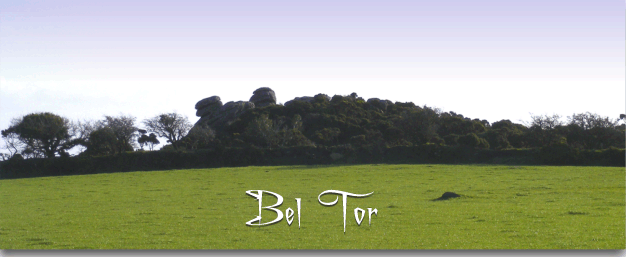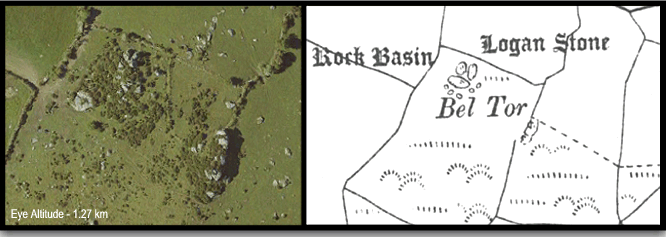
“Oh, yet, ye solemn Altars! while I feel
The shadowy spells of power that round ye dwell.”
J. E. Reade -1843
“On the left within a farm enclosure is Bel Tor, which although only a small pile, is sufficiently interesting to call for notice. A gate in the wall will enable the rambler to visit reach it. On the surface of a logan, curiously poised and appearing as though it would topple over at any moment, is a rock basin measuring 38 inches by 32, with shelving sides, and to this a tradition attaches. It used to be said that good fortune would await anyone seeing the reflection of the rising sun collected in it. As health is to be more valued than wealth as early rising is conducive to the former, there is perhaps more truth in this than might first appear.” Crossing, pp. 336 -337.
Firstly I must point out that despite Crossing talking about the; “gate in the wall will enable the rambler to reach it,” this is no longer the case as Bel Tor now sits smugly on private land. Although good views of the tor can be obtained from the roadside and even better ones down the adjacent lane. However, not to be discouraged….
From William Crossing’s remarks it can be assumed that as Bel Tor has both a logan stone and rock basins whose associated traditions stems back to the early belief that such rock formations were the work of the Druids and used for their various rituals. To further idea of early Druidical connections to the tor Eliza Bray writes: “The sun that universal object of adoration even from the earliest times heathen nations, was also held sacred by the Druids, and the noblest altars and temples were dedicated to his honour. The sun was adored under various names, but none more commonly than that of Belus or Bel; and on Dartmoor we have Bel-tor.”, pp. 56 -57.
So here we have a clear demonstration of the early antiquarian belief that Bel Tor along with its rock basins and logan stone was a Druidical temple to the sun god Belus. This then nicely links with the tradition of seeing the reflection of the sun rise in the waters of the rock basin in order to solicit good fortune. Another thought, why was it that the sunrise had to be observed in the water’s reflect as opposed to looking directly at it.
On Dartmoor there was another practice which took place known as ‘Sun Dancing‘, this is where on Easter Morning folk would traipse up to Ripon Tor to see the sun rise. This was done as a celebration of Christ’s resurrection. However, in 1872 a contributor to the ‘Sunday School Magazine’ considered that this practice was carried out on Bel Tor. He wrote: “These and other ceremonies have, I feel convinced, been performed on Bel Tor, and a custom which still remains among the old people of the neighbourhood of seeing the sun dance in the basin of water at sunrise on Easter day, is undoubtedly a relic of Pagan rites retained by a crafty priesthood, who artfully yielded to the superstitions of their early converts, and thus grafted Christianity upon Paganism.” I must admit this is a very poignant observation which can apply to numerous Pagan traditions and monuments on and around Dartmoor that have been Christianised.
“The lesser hills in shadows hid their heads;
Bel-Tor alone, sublimest spirit! caught
The day-god’s crown, his forehead forward bowed,
Glowing with holiest ecstasy.”
J. E. Reade -1843
Could there be something about the surrounding landscape of Bel Tor that attracted ancient rituals? The only reason being that about a third of a mile south of the tor is Mel or Mil Tor. It was here that an old custom whereby flaming wheels would be rolled down the hill, the aim being that they should reach the river Dart below. Should this be accomplished then good fortune would be guaranteed for the local community.

The actual tor itself actual consist of two piles and sits at an altitude of 354 metres, the famous rock basin of good fortune measures about 1.06 by 0..91 metres and is 7.6 centimetres deep. There are also two other rock basins on the southern pile. Back in the fourteenth century the tor was documented as being ‘Bellettor‘ and has since mutated to Bel Tor. For anybody interested in Ordnance Survey trig points the one on Bel Tor is number 3469.

If you would like a journey into the realms of the supernatural then there is tale regarding a herd of white horses. Apparently on a certain night of the year a herd of ghostly white horses gallop through the village of Ipplepen and hurtle up towards Dartmoor. When they reach Bel Tor they charge up to the summit and plunge off the top to their fated doom below. The actual journey from Ipplepen to Bel Tor is about twelve and a half miles and so why this should be is anyone’s guess.
For a tor that many Dartmoor topographical writers consider as having no or little interest I would argue that Druids, rock basins, logan stones, ancient rituals and ghostly white horses more than merit some interest.

Bray. E. 1838. Traditions, legends, superstitions, and sketches of Devonshire. London: J. Murray.
Crossing, W. 1990. Crossing’s Guide to Dartmoor. Newton Abbot: Peninsula Press.
 Legendary Dartmoor The many aspects past and present of Dartmoor
Legendary Dartmoor The many aspects past and present of Dartmoor
